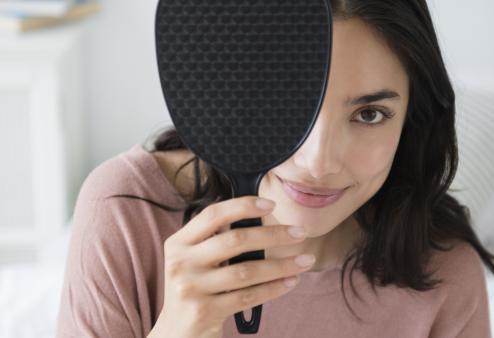
From eye exams to a cool pair of sunglasses, you have the power to protect your vision. Seize it.

Imagine if you could only see your favorite Netflix show from behind a thick piece of wax paper. Sounds depressing, right? That's how the eye doctor describes what it’s like to navigate the world with cataracts, an eye disease that affects more than 24 million Americans.
If you have only a vague idea of what cataracts are, you’re not alone. Most cataracts aren’t detected until people are well into their 60s or 70s, which is why we don’t give them much thought.
But cataracts often begin forming much earlier in life, when there’s still time to act, says optometrist Stephanie Hubbard, O.D., of Crystal Clear Eye Associates, located inside an America’s Best Contacts & Eyeglasses in Sarasota, Fla.
For the record, cataracts are cloudy areas in your eye’s lens that happen when normal proteins break down and form clumps. They distort your vision and have the potential to completely rob you of your eyesight. But there’s good news: A 10-year delay in the development of cataracts would produce a 45 percent reduction in the need for cataract surgeries.
Bottom line: Brushing off cataracts as “an old person’s problem” is a missed opportunity. Here are five things you can do right now to minimize your risk.
Have questions about your eye health or vision? Your America’s Best optometrist is here to help. Book an exam time that fits your schedule. Find a store near you.
1. Book an Eye Exam
Even if you have 20/20 vision, the American Optometric Association says it’s a good idea for all adults to have regular eye checkups every two years until age 65, and every year after that.
Although most cataracts are age-related and will develop slowly, the very first signs often appear when you’re in your early 40s, explains Dr. Hubbard. They usually won’t impact your vision that early, but your eye doctor can pick them up during a comprehensive eye exam that includes widening (or dilating) the pupil.
“I’ll usually see a yellowish tinge or some clouding on the eye’s lens,” she says. “That’s when I start to talk about the patient’s individual risk factors and prevention measures to slow down the progression.”
Some people see their vision improve with new prescription lenses or with an antiglare lens coating. More advanced cataracts often need surgery to undo the problem.
Take two minutes right now to book your next eye exam. Your future self will thank you.

2. Keep Your Shades On
More than just a style statement, sunglasses also blunt the effects of strong exposure to the sun’s ultraviolet (UV) light rays.
“UV protection is the most inexpensive and easy-to-follow cataract prevention measure,” says Dr. Hubbard. “All you need to do is remember to wear your sunglasses.”
Be sure to pick shades that block 100% of UVA and UVB rays. The protection rating is printed on the frame—look for a UV 400 rating or higher. Oversized frames and wraparound styles can help prevent UV rays from entering at the sides. Your eye doctor can even prescribe eyeglasses that have a clear anti-UV coating, or contact lenses with UV protection, to further minimize your risk.
3. Sweat Regularly
Every time you go for a walk instead of vegging on the couch, you’re delivering a powerful dose of natural cataract prevention to your eyes. Obesity is an independent risk factor for cataracts, according to the World Health Organization. And exercise is key for losing weight and for keeping it in check.
Although the clear connection between obesity and eye diseases is still being examined, researchers at the Centre for Eye Research Australia believe that carrying too many pounds may overwhelm the body’s immune system and harm lens proteins.
Shoot for at least 30 minutes of brisk walking or other moderate exercise five days a week. Find an activity you enjoy and stick with it.
4. Eat the Rainbow
How you fill your plate matters too. A Nurses’ Health Study revealed that women who ate higher amounts of vegetables and fruits were half as likely to develop cataracts as women who didn’t maintain a balanced diet.
Brightly colored produce is chock full of all kinds of antioxidants, particularly vitamins C and E, which neutralize free radicals that take, take, take from the healthy cells in your eye, leaving them damaged. Working a wide variety of vegetables and fruits into your meals can kick-start the repair process.
Need a snack? Try a handful of almonds or sunflower seeds for an extra boost of vitamin E, which studies show helps delay cataract formation. (Check out five more eye-friendly foods here.)
5. Quit Tobacco
Lighting up at any age can lead to or accelerate many eye problems, including your risk of cataracts.
Tobacco smoke cuts the supply of antioxidants in your eye. Heavy smokers, who go through 15 or more cigarettes a day, have three times the risk of developing cataracts as nonsmokers. The good news: Quitting drops the threat of cataracts.
Ready to quit? Talk to your eye doctor or family physician about resources, including medications and counseling services, that may help you stop. Not enough is known about the effects of vaping on eye health to recommend it as a safe way to break a tobacco habit.
“Everyone’s risk factors for cataracts are different, but following these tips is a good start to improving your overall eye health for life,” says Dr. Hubbard.



